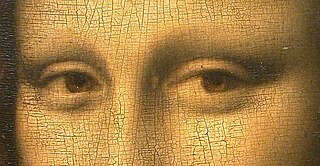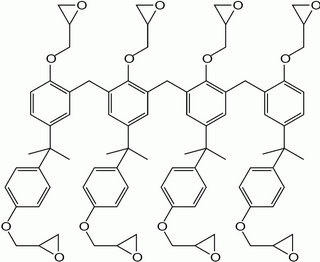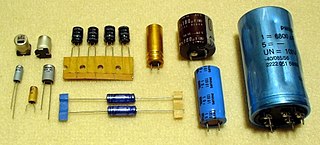Related Research Articles

Acrylic paint is a fast-drying paint made of pigment suspended in acrylic polymer emulsion and plasticizers, silicone oils, defoamers, stabilizers, or metal soaps. Most acrylic paints are water-based, but become water-resistant when dry. Depending on how much the paint is diluted with water, or modified with acrylic gels, mediums, or pastes, the finished acrylic painting can resemble a watercolor, a gouache, or an oil painting, or have its own unique characteristics not attainable with other media.

Oil painting is the process of painting with pigments with a medium of drying oil as the binder. It has been the most common technique for artistic painting on wood panel or canvas for several centuries, spreading from Europe to the rest of the world. The advantages of oil for painting images include "greater flexibility, richer and denser colour, the use of layers, and a wider range from light to dark". But the process is slower, especially when one layer of paint needs to be allowed to dry before another is applied.

Paint is any pigmented liquid, liquefiable, or solid mastic composition that, after application to a substrate in a thin layer, converts to a solid film. It is most commonly used to protect, color and primer, or provide texture. Paint can be made in many colors—and in many different types. Paint is typically stored, sold, and applied as a liquid, but most types dry into a solid. Most paints are either oil-based or water-based, and each has distinct characteristics. For one, it is illegal in most municipalities to discard oil-based paint down household drains or sewers. Clean-up solvents are also different for water-based paint than oil-based paint. Water-based paints and oil-based paints will cure differently based on the outside ambient temperature of the object being painted. Usually, the object being painted must be over 10 °C (50 °F), although some manufacturers of external paints/primers claim they can be applied when temperatures are as low as 2 °C (35 °F).

In chemistry, a solution is a special type of homogeneous mixture composed of two or more substances. In such a mixture, a solute is a substance dissolved in another substance, known as a solvent. If the attractive forces between the solvent and solute particles are greater than the attractive forces holding the solute particles together, the solvent particles pull the solute particles apart and surround them. These surrounded solute particles then move away from the solid solute and out into the solution. The mixing process of a solution happens at a scale where the effects of chemical polarity are involved, resulting in interactions that are specific to solvation. The solution usually has the state of the solvent when the solvent is the larger fraction of the mixture, as is commonly the case. One important parameter of a solution is the concentration, which is a measure of the amount of solute in a given amount of solution or solvent. The term "aqueous solution" is used when one of the solvents is water.

Spray drying is a method of forming a dry powder from a liquid or slurry by rapidly drying with a hot gas. This is the preferred method of drying of many thermally-sensitive materials such as foods and pharmaceuticals, or materials which may require extremely consistent, fine particle size. Air is the heated drying medium; however, if the liquid is a flammable solvent such as ethanol or the product is oxygen-sensitive then nitrogen is used.

Varnish is a clear transparent hard protective coating or film. It is not to be confused with wood stain. It usually has a yellowish shade due to the manufacturing process and materials used, but it may also be pigmented as desired. It is sold commercially in various shades.

A drying oil is an oil that hardens to a tough, solid film after a period of exposure to air, at room temperature. The oil hardens through a chemical reaction in which the components crosslink by the action of oxygen. Drying oils are a key component of oil paint and some varnishes. Some commonly used drying oils include linseed oil, tung oil, poppy seed oil, perilla oil, and walnut oil. Their use has declined over the past several decades, as they have been replaced by alkyd resins and other binders.

Column chromatography in chemistry is a chromatography method used to isolate a single chemical compound from a mixture. Chromatography is able to separate substances based on differential adsorption of compounds to the adsorbent; compounds move through the column at different rates, allowing them to be separated into fractions. The technique is widely applicable, as many different adsorbents can be used with a wide range of solvents. The technique can be used on scales from micrograms up to kilograms. The main advantage of column chromatography is the relatively low cost and disposability of the stationary phase used in the process. The latter prevents cross-contamination and stationary phase degradation due to recycling. Column chromatography can be done using gravity to move the solvent, or using compressed gas to push the solvent through the column.

Craquelure is a fine pattern of dense cracking formed on the surface of materials. It can be a result of drying, aging, intentional patterning, or a combination of all three. The term is most often used to refer to tempera or oil paintings, but it can also develop in old ivory carvings or painted miniatures on an ivory backing. Recently, analysis of craquelure has been proposed as a way to authenticate art.

Wood stain is a type of paint used to colour wood and consists of colourants dissolved and/or suspended in a 'vehicle' or solvent. Vehicle is the preferred term, as the contents of a stain may not be truly dissolved in the vehicle, but rather suspended, and thus the vehicle may not be a true solvent. The vehicle often may be water, alcohol, a petroleum distillate, or a finishing agent such as shellac, lacquer, varnish and polyurethane. Coloured or stained finishes do not typically deeply penetrate the pores of the wood and may largely disappear when the finish deteriorates or is removed.

A primer or undercoat is a preparatory coating put on materials before painting. Priming ensures better adhesion of paint to the surface, increases paint durability, and provides additional protection for the material being painted.

Powder coating is a type of coating that is applied as a free-flowing, dry powder. Unlike conventional liquid paint which is delivered via an evaporating solvent, powder coating is typically applied electrostatically and then cured under heat or with ultraviolet light. The powder may be a thermoplastic or a thermoset polymer. It is usually used to create a hard finish that is tougher than conventional paint. Powder coating is mainly used for coating of metals, such as household appliances, aluminium extrusions, drum hardware, automobiles, and bicycle frames. Advancements in powder coating technology like UV-curable powder coatings allow for other materials such as plastics, composites, carbon fiber, and MDF to be powder coated due to the minimum heat and oven dwell time required to process these components.

SU-8 is a commonly used epoxy-based negative photoresist. Negative refers to a photoresist whereby the parts exposed to UV become cross-linked, while the remainder of the film remains soluble and can be washed away during development.
Conformal coating is a protective coating of thin polymeric film applied to printed circuit boards (PCB). The coating is named conformal since it conforms to the contours of the PCB. Conformal coatings are typically applied at 25–250 μm to the electronic circuitry and provides protection against moisture, dust, chemicals and temperature extremities.

Automotive paint is paint used on automobiles for both protective and decorative purposes. Water-based acrylic polyurethane enamel paint is currently the most widely used paint for reasons including reducing paint's environmental impact.

Coating is a process that consists of applying a liquid or a powder into the surface of an edible product to convey new properties. Coating designates an operation as much as the result of it: the application of a layer and the layer itself. Coating takes different meanings depending on the industry concerned.
A biomimetic antifouling coating is a treatment that prevents the accumulation of marine organisms on a surface. Typical antifouling coatings are not biomimetic but are based on synthetic chemical compounds that can have deleterious effects on the environment. Prime examples are tributyltin compounds, which are components in paints to prevent biofouling of ship hulls. Although highly effective at combatting the accumulation of barnacles and other problematic organisms, organotin-containing paints are damaging to many organisms and have been shown to interrupt marine food chains.
Paint has four major components: pigments, binders, solvents, and additives. Pigments serve to give paint its color, texture, toughness, as well as determining if a paint is opaque or not. Common white pigments include titanium dioxide and zinc oxide. Binders are the film forming component of a paint as it dries and affects the durability, gloss, and flexibility of the coating. Polyurethanes, polyesters, and acrylics are all examples of common binders. The solvent is the medium in which all other components of the paint are dissolved and evaporates away as the paint dries and cures. The solvent also modifies the curing rate and viscosity of the paint in its liquid state. There are two types of paint: solvent-borne and water-borne paints. Solvent-borne paints use organic solvents as the primary vehicle carrying the solid components in a paint formulation, whereas water-borne paints use water as the continuous medium. The additives that are incorporated into paints are a wide range of things which impart important effects on the properties of the paint and the final coating. Common paint additives are catalysts, thickeners, stabilizers, emulsifiers, texturizers, biocides to fight bacterial growth, etc.

Aluminum electrolytic capacitors are polarized electrolytic capacitors whose anode electrode (+) is made of a pure aluminum foil with an etched surface. The aluminum forms a very thin insulating layer of aluminum oxide by anodization that acts as the dielectric of the capacitor. A non-solid electrolyte covers the rough surface of the oxide layer, serving in principle as the second electrode (cathode) (-) of the capacitor. A second aluminum foil called “cathode foil” contacts the electrolyte and serves as the electrical connection to the negative terminal of the capacitor.

A vehicle vinyl wrap describes the automotive aftermarket practice of completely or partially covering a vehicle's original paint with a vinyl wrap. Generally this vinyl wrap will be a different color or finish like a gloss, matte or clear protective layer. Other terms used to refer to vehicle vinyl wrap are car wrap, paint wrap, color change wrap, vehicle graphics, and paint protection film.
References
- 1 2 Hansen, William; Brown, Michael. "How much does that can of paint really cost?". Plant Services. Retrieved 17 February 2012.
- ↑ "Best Ceiling Paint in 2021 + Timesaving Tips | Brad the Painter".